Planning a trip to Alaska often starts with a fundamental question: when is the best time to visit? The sheer size and diverse geography of the state mean the Alaska Climate By Month varies dramatically from one region to another and throughout the year. While the peak travel season is short, each month offers unique opportunities and challenges influenced by weather patterns, daylight hours, and wildlife activity. Understanding these monthly variations is key to planning your ideal Alaskan adventure, whether you’re seeking wildlife encounters, dramatic landscapes, or cultural experiences. This guide delves into the nuances of Alaska’s climate month by month to help you determine the perfect time for your journey.
Alaska is a land of incredible extremes, from the temperate rainforests of the southeast coast to the frozen tundra of the Arctic. The primary tourist season typically runs from late spring through early fall, aligning with the warmest temperatures and longest daylight hours. However, traveling outside this window can reveal a different, equally captivating side of the Last Frontier. Our exploration of the Alaska climate by month will cover what to expect across the coastal, interior, and Arctic regions, highlighting the benefits and considerations for each period.
A Detailed Look at Alaska Climate By Month
Experiencing Alaska is deeply tied to its seasonal climate. The timing of your visit impacts everything from accessibility to national parks to the specific wildlife you might encounter. Let’s break down the Alaska Climate By Month, exploring the typical conditions and unique highlights each period offers to travelers.
April
April marks the very beginning of the travel season in Alaska’s coastal regions. Small cruise ships start navigating the Inside Passage, taking advantage of increasing daylight and warming temperatures. Wildlife begins to stir; bears emerge from hibernation, and marine life like humpback whales and orcas follow the Pacific herring migration. While still cool, particularly in the interior and Arctic, April offers the benefit of fewer crowds and lower prices, making it an attractive option for budget-conscious or solitude-seeking travelers. The nights are still dark enough in early April for potential Northern Lights viewing in certain areas before daylight dominates.
Coastal Temperature: 30-45°F
Interior Temperature: 15-40°F
Arctic Temperature: -10-5°F
Coastal Daylight: 11 hours
Interior Daylight: 14 hours
Arctic Daylight: 16 hours
May
May is considered spring in Alaska. It’s one of the driest months, especially along the coast, offering clear skies that are perfect for scenic flights or photography. Many small ship cruises ramp up operations, although land-based infrastructure like national park roads may still be opening. This is a time of rapid change: snow melts, landscapes bud, and wildlife is increasingly active with many young animals being born. May provides a sweet spot with pleasant weather, vibrant scenery, and significantly fewer visitors compared to the peak summer months. It’s an excellent time for those who prefer a quieter experience before the summer rush.
What to Eat in Fort Worth – A Culinary Deep Dive
11 Must-Visit places to go in nevada for Your 2025 Trip
12 Unforgettable Fun Things to Do in Vegas for Couples
Coastal Temperature: 40-55°F
Interior Temperature: 30-55°F
Arctic Temperature: 15-24°F
Coastal Daylight: 16 hours
Interior Daylight: 18 hours
Arctic Daylight: 22 hours
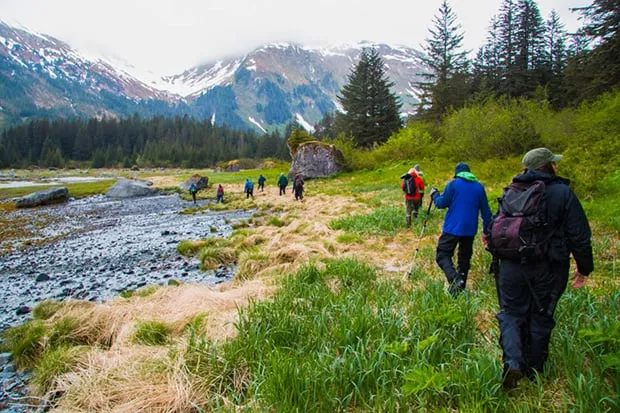 A group of Alaska travelers hiking along a creek.
A group of Alaska travelers hiking along a creek.
June
June marks the official start of summer and the high season. Daylight hours are near their maximum, offering the famous “Midnight Sun” in northern regions. This means more time for exploration and increased wildlife activity. Denali National Park road typically opens fully by mid-June, allowing access to the park’s interior. Cruising options expand to Southcentral and Southwest Alaska. Bear viewing is excellent as salmon runs begin. June is a vibrant month with lush green landscapes and abundant opportunities for hiking and exploring remote wilderness areas. It’s a popular time, so booking in advance is essential.
Coastal Temperature: 40-60°F
Interior Temperature: 50-70°F
Arctic Temperature: 29-38°F
Coastal Daylight: 18 hours
Interior Daylight: 20 hours
Arctic Daylight: Nearly 24 hours
July
Often cited as the warmest month, July is the peak of the Alaskan summer. With long days and generally milder temperatures, all trails, parks, and visitor services are fully operational. This translates to a surge in visitors across the state. Wildlife is highly active, with salmon runs in full swing, attracting bears and eagles. Humpback whales are abundant in feeding grounds. While popular and potentially crowded, July offers the most consistent and comfortable conditions for experiencing Alaska’s diverse activities, from hiking and fishing to wildlife viewing and glacier tours.
Coastal Temperature: 50-65°F
Interior Temperature: 50-70°F
Arctic Temperature: 33-45°F
Coastal Daylight: 18 hours
Interior Daylight: 19 hours
Arctic Daylight: Nearly 24 hours
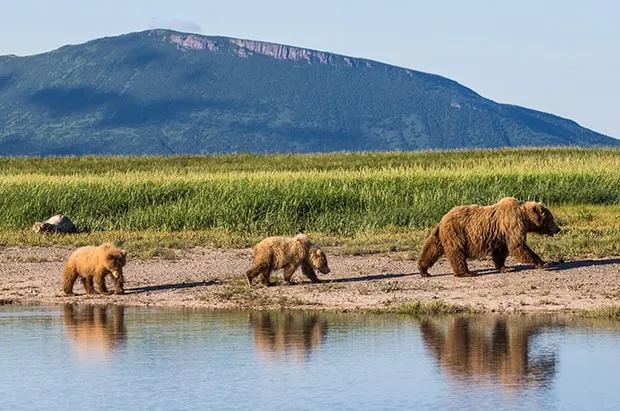 Three coastal brown bears walking along a pond with their reflections showing and a green meadow behind them in Alaska.
Three coastal brown bears walking along a pond with their reflections showing and a green meadow behind them in Alaska.
August
August continues to be a popular time to visit, though it marks the beginning of the transition out of the high season. The landscape is incredibly green early in the month, transitioning to stunning fall colors by mid-August, particularly in the interior. Moisture increases, making the scenery vibrant. Wildlife remains active as animals prepare for winter. As the month progresses, daylight hours begin to noticeably decrease, and temperatures start to cool. Late August sees fewer crowds than July, offering a good balance of conditions, accessibility, and slightly lower visitor numbers.
Coastal Temperature: 50-60°F
Interior Temperature: 45-65°F
Arctic Temperature: 33-41°F
Coastal Daylight: 18 hours
Interior Daylight: 18 hours
September
September falls into Alaska’s autumn shoulder season. The most dramatic change is the landscape ablaze with fall colors, especially evident in the interior and tundra regions. Cooler temperatures arrive, and snow dusts the mountain peaks. Daylight hours decrease significantly, bringing back the potential for viewing the Northern Lights in darker skies, usually starting mid-month in interior and northern areas. Wildlife is still active as they forage and prepare for winter, often making them easier to spot. September offers lower prices and fewer crowds than summer, appealing to travelers seeking scenic beauty and a quieter experience.
Coastal Temperature: 40-55°F
Interior Temperature: 35-55°F
Arctic Temperature: 28-33°F
Coastal Daylight: 15 hours
Interior Daylight: 17 hours
Arctic Daylight: 14 hours
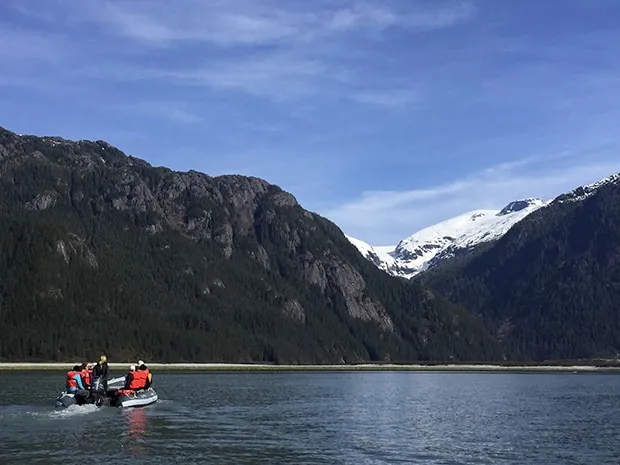 Alaska travelers in a skiff heading towards a beach under steep mountains in Alaska.
Alaska travelers in a skiff heading towards a beach under steep mountains in Alaska.
October & November
These late fall months see a significant drop in visitor numbers and available tours. The weather becomes wetter and colder across much of the state. Wildlife is less active or has migrated. While limited specialty tours or custom arrangements might be possible, it’s generally considered off-season for mainstream tourism. Most cruise lines and land tour operators cease operations.
Winter (December Through March)
Alaska’s winter is long, cold, and dark, but also incredibly beautiful. Snow covers the landscape, enabling activities like dog sledding, skiing, and snowshoeing. The short daylight hours mean ample darkness, making winter the prime time to witness the spectacular Northern Lights, especially in the interior and Arctic regions. While challenging due to extreme cold and potential storms, winter offers a unique, serene, and adventurous Alaskan experience for those prepared for the conditions. Visitor services are limited, but dedicated winter lodges and tours cater to those seeking aurora viewing and winter sports.
Planning Your Trip: Activities by Alaska Climate By Month
The specific activities you can enjoy in Alaska are highly dependent on the Alaska Climate By Month. Summer (June-August) offers the widest range of options, including extensive hiking, fishing, kayaking, and accessibility to most national parks. This is when the warmest temperatures and longest daylight hours make outdoor adventures most comfortable and feasible across all regions.
Shoulder seasons (April-May, September) provide unique opportunities. April and May on the coast are great for early-season cruises focusing on wildlife emerging from winter. September’s cooler climate and changing leaves are ideal for scenic drives and photography, while also being the start of Northern Lights viewing season. Winter (December-March) transforms Alaska into a snowy playground, perfect for aurora chasers and winter sports enthusiasts, though travel logistics require careful planning due to weather and reduced services.
Wildlife Encounters Aligned with Alaska Climate By Month
Wildlife viewing is a major draw for Alaska, and the best time to see specific animals is directly influenced by the Alaska Climate By Month and their natural cycles.
Humpback whales are most reliably seen in feeding pods from mid-June through mid-August, coinciding with the peak phytoplankton blooms driven by long summer daylight. Earlier in spring (April-May), you might see gray whales migrating north and humpbacks arriving, but they are more dispersed. Bears are active from spring emergence (April) through fall (September), with peak viewing tied to food sources like salmon runs (typically July-August). Migratory birds arrive in spring and depart in fall. Understanding these cycles in relation to the monthly climate helps maximize your chances of seeing your target wildlife.
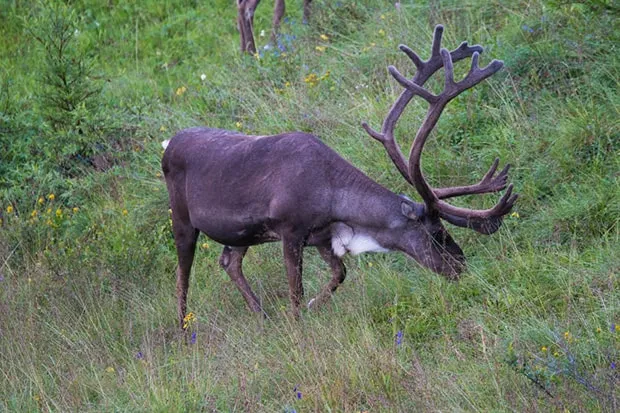 A caribou with large antlers munching on grass on a wildflower filled hillside.
A caribou with large antlers munching on grass on a wildflower filled hillside.
Navigating Mosquito Season in Relation to Alaska Climate By Month
Mosquitoes are a common concern for visitors, particularly during summer. Their prevalence is directly linked to the warmer, wetter conditions of mid-summer (late June through early August). They are most numerous in the interior and Arctic regions, where bogs and standing water provide breeding grounds. Coastal and mountainous areas, especially those with a breeze, tend to have fewer mosquitoes. While they can be an annoyance, they shouldn’t deter your travel plans. Packing appropriate repellents and clothing is key to mitigating their impact. Mosquitoes are less of an issue in the cooler spring and fall months.
Essential Packing Tips for Alaska’s Varied Climate
Given the unpredictable nature of the Alaska Climate By Month, packing in layers is crucial regardless of when you visit. Temperatures can fluctuate significantly within a single day. Fast-drying, moisture-wicking base layers are recommended. A waterproof and windproof outer layer (jacket and pants) is essential, as rain is possible any time of year. Warm hats, gloves, and sturdy, waterproof footwear are also must-haves. Many tours and lodges provide rubber boots. Being prepared for various conditions ensures you can comfortably enjoy your planned activities and spontaneous opportunities.
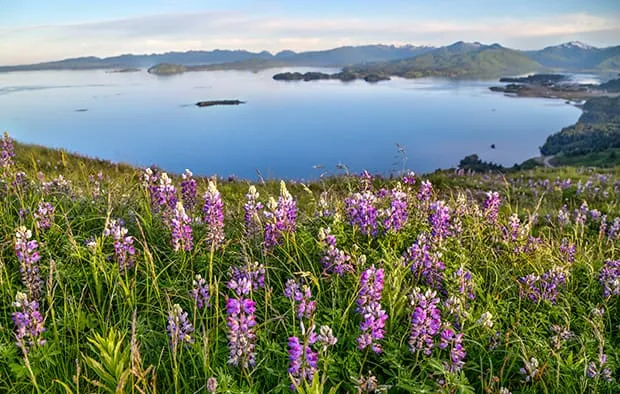 A scenic view of a mountainside of lupine flower plant overlooking an Alaskan shoreline and water.
A scenic view of a mountainside of lupine flower plant overlooking an Alaskan shoreline and water.
Understanding Regional Variations and Latitude
Alaska’s vastness means that climate and conditions vary greatly by region and latitude. The coastal areas (like Southeast and Southcentral) are generally milder and wetter than the interior, which experiences greater temperature extremes. The Arctic north has the coldest temperatures and the most dramatic changes in daylight hours. When planning your trip, it’s important to consider the specific regions you intend to visit and factor in their unique climate characteristics relative to the statewide averages for each month. Higher latitudes experience more pronounced “Midnight Sun” in summer and extended darkness in winter.
Alaska Climate By Month: Detailed Tables
These tables provide average climate data for key locations across Alaska, helping visualize the typical temperatures, rainfall, and daylight hours you can expect when planning your visit based on the Alaska Climate By Month.
Anchorage, Alaska
| Month | Jan | Feb | Mar | Apr | May | Jun | Jul | Aug | Sep | Oct | Nov | Dec |
|---|---|---|---|---|---|---|---|---|---|---|---|---|
| Avg. High (F) | 22 | 26 | 33 | 44 | 55 | 62 | 65 | 63 | 55 | 40 | 28 | 22 |
| Avg. Low (F) | 9 | 12 | 17 | 28 | 39 | 47 | 52 | 49 | 41 | 58 | 16 | 10 |
| Avg. Rainfall (Inches) | 0.7 | 0.8 | 0.6 | 0.5 | 0.7 | 1.0 | 1.9 | 2.7 | 2.6 | 1.9 | 1.0 | 1.1 |
| Avg. Daylight (Hours) | 5.5 | 7.5 | 10 | 13 | 17 | 19 | 19 | 17 | 14 | 11.5 | 8.5 | 6 |
Juneau, Alaska
| Month | Jan | Feb | Mar | Apr | May | Jun | Jul | Aug | Sep | Oct | Nov | Dec |
|---|---|---|---|---|---|---|---|---|---|---|---|---|
| Avg. High (F) | 30 | 34 | 39 | 47 | 55 | 62 | 64 | 63 | 56 | 47 | 38 | 33 |
| Avg. Low (F) | 19 | 23 | 27 | 32 | 39 | 45 | 48 | 48 | 43 | 37 | 29 | 24 |
| Avg. Rainfall (Inches) | 4.3 | 4.0 | 3.4 | 2.9 | 3.5 | 3.1 | 4.4 | 5.4 | 7.2 | 7.9 | 5.4 | 5.1 |
| Avg. Daylight (Hours) | 6.5 | 8 | 10.5 | 13 | 16 | 18 | 18 | 16.5 | 14 | 11.5 | 9 | 7 |
Denali National Park
| Month | Jan | Feb | Mar | Apr | May | Jun | Jul | Aug | Sep | Oct | Nov | Dec |
|---|---|---|---|---|---|---|---|---|---|---|---|---|
| Avg. High (F) | 10 | 16 | 25 | 39 | 53 | 64 | 66 | 61 | 51 | 32 | 18 | 11 |
| Avg. Low (F) | -1 | -5 | 1 | 15 | 29 | 39 | 43 | 38 | 31 | 14 | 1 | -6 |
| Avg. Rainfall (Inches) | 4.3 | 4.0 | 3.4 | 2.9 | 3.5 | 3.1 | 4.4 | 5.4 | 7.2 | 7.9 | 5.4 | 5.1 |
| Avg. Daylight (Hours) | 7 | 9 | 12 | 14.5 | 17.5 | 19 | 17 | 14 | 11.5 | 10 | 7 | 6 |
Arctic Alaska
| Month | Jan | Feb | Mar | Apr | May | Jun | Jul | Aug | Sep | Oct | Nov | Dec |
|---|---|---|---|---|---|---|---|---|---|---|---|---|
| Avg. High (F) | -8 | -12 | -10 | 5 | 24 | 38 | 45 | 41 | 33 | 18 | 4 | -4 |
| Avg. Low (F) | -19 | -22 | -20 | -10 | 15 | 29 | 33 | 33 | 28 | 9 | -7 | -17 |
| Avg. Daylight (Hours) | 4 | 8 | 12 | 16 | 22 | 24 | 24 | 20 | 14 | 10 | 4 | 2 |
So, When is the Best Time to Visit Alaska Based on Climate?
Ultimately, the “best” time to visit Alaska depends on your priorities and what you want to experience, all filtered through the lens of the Alaska Climate By Month. The peak season from mid-June to mid-August generally offers the most favorable weather, maximum daylight, and peak wildlife activity, making it ideal for first-time visitors seeking the quintessential Alaskan summer. However, this popularity means larger crowds and higher prices.
Traveling during the shoulder seasons (May, September) allows for great experiences with fewer people and often better value, though weather can be more variable. Early spring offers unique wildlife viewing and potential Northern Lights, while fall boasts incredible scenery. Winter is perfect for aurora viewing and snow activities if you can brave the cold. By considering the Alaska Climate By Month and aligning it with your interests, you can choose the time that promises your most rewarding Alaskan adventure.
Frequently Asked Questions About Alaska Climate By Month
What is the warmest month in Alaska?
Generally, July tends to be the warmest month across most regions of Alaska, offering the highest average temperatures during the peak of summer.
When is the driest time to visit Alaska?
May is often considered the driest month in Alaska, particularly along the coastal areas, offering clearer skies before the wetter summer and fall periods.
When is the best time for whale watching in Alaska?
The best time to see humpback whales in their feeding pods is typically from mid-June through mid-August, aligning with the peak of the food chain stimulated by long daylight hours.
Can I see the Northern Lights in Alaska during the summer?
Due to the extreme daylight hours (Midnight Sun) during the Alaskan summer (May-August), it is generally too bright to see the Northern Lights. The best time for aurora viewing is during the darker months, from September through April.
When is mosquito season most active in Alaska?
Mosquitoes are most prevalent during mid-summer, typically from late June through early August, especially in interior and Arctic regions with standing water. They are less active on the coast or in windy conditions.
